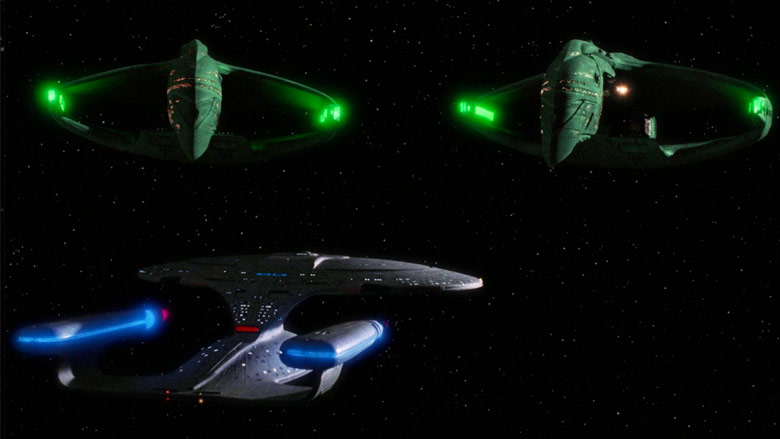
Screengrab from CBS The Enterprise-D versus two Romulan War Birds.
The Federation of Planets was long thought to be the “Star Trek” equivalent of the United Nations, which operated in a predominantly democratic manner on behalf of its member planets. Trek creator Gene Roddenberry mentioned the Federation just a few times in his TOS Writer’s Guide. Still, he did say that his vision of the future is “an automated, regimented, in-human Earth Federation.” While Roddenberry may have laid the groundwork for this idea, the term “Federation of Planets” was actually coined by Gene Coon, one of the key producers on TOS.
Since then, the idea of the Federation has been fleshed out a whole lot more, and fans can watch its birth on “Star Trek: Enterprise” and its death on “Star Trek: Discovery.” Some fans equate the Federation to real-life organizations, like the European Union, NATO, or even the United States.
What sets the Federation apart from its rivals in the Alpha Quadrant and beyond is that there is no one dominant planet or empire that wields power. Indeed, Earth plays a primary role in steering Federation policy — much like how the United States was arguably the most critical voice in the United Nations following World War II. But humanity shares seats at the Federation table with many other species, including the Vulcans, Tellarites, Anorians, and many others.
Starfleet is the quasi space police for the Federation, but the charter for the organization clearly states that it is one of exploration — not combat.
Recently, one Trek fan wondered aloud on Twitter, if the Federation has so many diverse members and societies under its umbrella, why is the technology not superior to its rivals?
Travis Johnson, who is also a host of the Trek-themed podcast, Black Alert, spoke briefly with Heavy on how he came to this thought.
“I have been doing a rewatch of all of Trek since October of last year,” said Johnson, who lives in Virginia. “And I’ve been doing it chronologically, so I started with ‘Enterprise,’ went to ‘Discovery,’ then ‘Original Series’ and ‘Animated Series,’ ‘Next Gen,’ and I’m concurrently watching ‘Deep Space Nine’ and ‘Voyager.’”
Johnson said that he was watching Voyager when the idea of tech parity came into his mind.
“There was this episode where we find out that Seska is a Cardassian,” said Johnson. “It kind of just got all the wheels turning. They mention that Seska was able to be surgically altered to look like a Bajoran. That made me think of the time when Kirk was surgically altered to look like a Romulan (in “The Enterprise Incident”).
Johnson’s thought provoked a discussion on Twitter. Many others chimed in their theory as to why Starfleet is basically ‘on par’ with the Romulans, Klingons, Cardassians, and others.
And:
There are a few canonical reasons why this difference could be true.
The Klingons Are A Threat, Because They Stole Technology
According to Klingon lore, they did not actually do what Zefram Cochrane did for Earth, creating a warp-capable ship. Instead, they acquired it from an alien race called the Hur’q. These insect-like marauders invaded Kronos (or Q’onoS), and the Klingons fought them off. They reverse-engineered the invaders’ warp engines and were able to join the other space-faring races.
Some argue that the Klingons may have science academies toiling away on advanced technology, and the shows, films, books, video games, and other media just have not yet shown these people.
The Romulans May Have The Best Tech
Since they are descendants of Vulcan, it makes sense that the Romulan Star Empire would have the very best technology available. Their cousins, the Vulcans, dedicate their time to peaceful and logical scientific pursuits. The Romulans possess this same intellect but are motivated by more emotional and sometimes sinister aims.
According to “Star Trek: The Next Generation Technical Journal” — which Lora Johnson wrote for the Starlog imprint — the Romulans traded their cloaking technology to the Klingons for some ships during their short-lived alliance.
Among the Romulans’ most remarkable achievements are their unique approach to faster-than-light travel. Unlike Starfleet, the Romulan ships are powered by a quantum singularity contained aboard their vessels. This is sort of like having a miniature black hole instead of a warp drive. This power was demonstrated during 2009’s “Star Trek” film, which saw the Romulans use a singularity to destroy Vulcan and travel through time.
The Romulans have been a thorn in the side of the Federation through all eras but proved to be anti-technology when it comes to artificial intelligence. This fear and loathing of artificial life were explored in “Star Trek: Picard.” And by the time of Picard, the Romulans are clearly still a viable threat.
Cardassians Have Fallen Behind
By the time we get to know them best, during “Deep Space Nine,” Cardassian ships and technology have fallen behind the Federation. While this would be true for some time, the superior ships of Starfleet were not enough to win the Federation-Cardassian War, which was fought to a stalemate.
This does not count the alliance that the Cardassians strike up with the Dominion, which make them a part of an incredibly powerful force.
Starfleet is Not Meant to Fight
Perhaps the real reason why ships that are part of Starfleet are not as heavily armed as the Klingons or as high-tech as the Romulans is because the mission of Starfleet is exploration — not battle.
If the Federation wanted to produce warships, they certainly could. The examples being the Enterprise-E, the Defiant, and the Dreadnought-class (U.S.S. Vengeance) in “Star Trek Into Darkness.”
READ NEXT: Will Brent Spiner Return as Soong or Android on ‘Star Trek: Picard?’